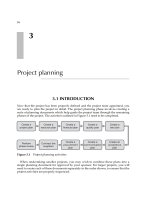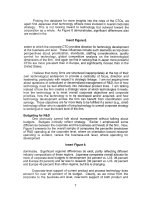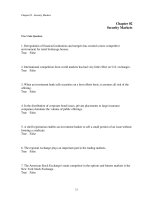Practice investment management pim3 ch03e ch 2 understanding risk return
Bạn đang xem bản rút gọn của tài liệu. Xem và tải ngay bản đầy đủ của tài liệu tại đây (785.21 KB, 32 trang )
CHAPTER THREE
THE MARKETPLACE
Practical Investment Management
Robert A. Strong
Outline
The Role of the Capital Markets
Economic Function
Continuous Pricing Function
Fair Pricing Function
The Exchanges
National Exchanges
Regional Exchanges
Trading Systems
• The Specialist System
• SuperDOT and NYSE Direct+
• Marketmakers
Circuit Breakers and Trading Curbs
South-Western / Thomson Learning © 2004
3-2
Outline
The Nasdaq Stock Market
The Small Order Execution System (SOES)
The Nasdaq National Market
The Nasdaq Small Cap Market
The Over-the-Counter Market
Over-the-Counter Bulletin Board (OTCBB)
Pink Sheet Stocks
Third and Fourth Markets
South-Western / Thomson Learning © 2004
3-3
Outline
Regulation
The Exchanges
The SEC
• Background
• Primary Acts
The NASD
SIPC
Ethics
Illegal vs. Unethical
The Chartered Financial Analyst Program
• History
• The CFA Program Exams
AIMR Standards of Professional Conduct
South-Western / Thomson Learning © 2004
3-4
The Role of the Capital Markets
An exchange serves three principal functions.
Economic Function
Continuous Pricing Function
Fair Pricing Function
South-Western / Thomson Learning © 2004
3-5
Economic Function
Even in the days before perestroika, socialism was never a monolith.
Within the Communist countries, the spectrum of socialism ranged
from the quasi-market, quasi-syndicalist system of Yugoslavia to the
centralized totalitarianism of neighboring Albania. One time I asked
Professor von Mises, the great expert on the economics of socialism, at
what point on this spectrum of statism would he designate a country as
"socialist" or not. At that time, I wasn't sure that any definite criterion
existed to make that sort of clear-cut judgment.
And so I was pleasantly surprised at the clarity and decisiveness of
Mises's answer. "A stock market," he answered promptly. "A stock
market is crucial to the existence of capitalism and private property.
For it means that there is a functioning market in the exchange of
private titles to the means of production. There can be no genuine
private ownership of capital without a stock market: there can be no
true socialism if such a market is allowed to exist."
- Murray Rothbard, from Making Economic Sense
South-Western / Thomson Learning © 2004
3-6
Economic Function
Capital markets facilitate the flow of
capital from savers to borrowers.
Capital
Savers
Borrowers
Capital Market
South-Western / Thomson Learning © 2004
3-7
Economic Function: An Example
Mortgage
$
Banks offer home
mortgages so that home
buyers who are short of
cash can borrow money
to buy houses.
Home Buyer
Home
Ownership
Bank
$
Home Seller
South-Western / Thomson Learning © 2004
3-8
Economic Function: An Example
Mortgage
Bank
Facilitated by
government agencies
such as the Federal National
Mortgage Association, banks
sell the mortgages to
investors with surplus cash.
$
Gov’t
Agency
$ Mortgagebacked
securities
Investors
South-Western / Thomson Learning © 2004
3-9
Economic Function
The primary market is the “new
securities” market where securities
are sold to the public for the first
time.
The secondary market is the “used securities”
market, where previously issued securities are
traded among security holders.
South-Western / Thomson Learning © 2004
3 - 10
Economic Function
Investor Group
Household sector
State/local governments
Rest of world
Bank trusts/estates
Life insurance companies
Other insurance companies
Private pension funds
State/local retirement funds
Mutual funds
Total
South-Western / Thomson Learning © 2004
Dollar Holdings
(billions)
$6,579
115
1,712
315
938
179
1,999
1,937
3,226
$17,000
% of Total
38.70%
0.68
10.07
1.85
5.52
1.05
11.76
11.39
18.98
100.00
3 - 11
Continuous Pricing Function
Capital markets enable market participants to
get accurate, up-to-date price information.
South-Western / Thomson Learning © 2004
3 - 12
Fair Pricing Function
Capital markets remove the fear that people
have of buying or selling at a rip-off price.
The greater the number of participants and
the more formal the marketplace, the
“fairer” the price.
South-Western / Thomson Learning © 2004
3 - 13
The Role of the Capital Markets
Functions of the Capital Markets
•Fair price function
•Continuous pricing function
•Economic function
South-Western / Thomson Learning © 2004
3 - 14
The Exchanges
United States
National Exchanges
New York Stock Exchange (NYSE)
American Stock Exchange (till 1999)
Regional Exchanges
e.g. Philadelphia Stock Exchange
International
Exchanges
e.g. England,
France,
Japan,
Thailand
Trading Systems
Specialists are charged with making a fair
and orderly market in one or more assigned
securities at posts on the exchange floor.
SuperDot and NYSE Direct+ are electronic
systems enabling NYSE firms to send
market and limit orders directly to the
specialists’ posts.
Marketmakers are groups of competing
individuals who maintain a fair and orderly
market through open outcry trading in pits
on the exchange floor.
South-Western / Thomson Learning © 2004
3 - 16
Circuit Breakers and Trading Curbs
Both trading curbs and circuit
breakers are designed to reduce
temporary volatility in the market.
At the NYSE, when the Dow Jones Industrial
Average fluctuates by more than 2%, the
circuit breaker is activated and computerized
trading becomes restricted.
When a trading curb is triggered, all trading at
the exchange is halted.
South-Western / Thomson Learning © 2004
3 - 17
The Nasdaq Stock Market
The Nasdaq (National Association of
Securities Dealers Automated Quotations)
market is a worldwide computerized linkup
of brokerage firms, investment houses and
large commercial banks.
The Nasdaq market is sometimes still
erroneously called the over-the-counter
(OTC) market.
South-Western / Thomson Learning © 2004
3 - 18
The Nasdaq Stock Market
In Nasdaq trading, bids and offers for
securities ranging from small unfamiliar
firms to some of the largest companies in
the world are posted to an electronic
bulletin board.
Trades of up to 1,000 shares can be
executed in less than one minute via the
Small Order Execution System (SOES).
South-Western / Thomson Learning © 2004
3 - 19
The Nasdaq Stock Market
The Nasdaq stock market comprises two
distinct markets:
The Nasdaq National Market. The largest
and most established firms in the
Nasdaq market are the national market
issues.
The Nasdaq Small Cap Market. These
small-cap issues have a low level of
capitalization.
South-Western / Thomson Learning © 2004
3 - 20
The Over-the-Counter Market
Today, the term OTC equity security refers
to an equity security that is not traded on
Nasdaq or a national or regional exchange.
OTC securities trade in two ways:
The OTC Bulletin Board (OTCBB) is a
regulated quotation service providing
real-time information.
Data on the smallest and often most
speculative pink sheet stocks can be
accessed via the Internet.
South-Western / Thomson Learning © 2004
3 - 21
Third and Fourth Markets
The trading of listed securities in the
Nasdaq market is known as the third
market.
Direct trades between large institutional
investors comprise the fourth market.
South-Western / Thomson Learning © 2004
3 - 22
The Over-the-Counter Market
Insert Figure 3-5 here.
South-Western / Thomson Learning © 2004
3 - 23
The Markets
Insert Figure 3-6 here.
South-Western / Thomson Learning © 2004
3 - 24
Regulation
The Exchanges have rules regarding…
the financial capacity of members
serving as stock specialists
the financial & market activity of listed
firms
the disclosure & annual reporting of
listed firms
South-Western / Thomson Learning © 2004
3 - 25









